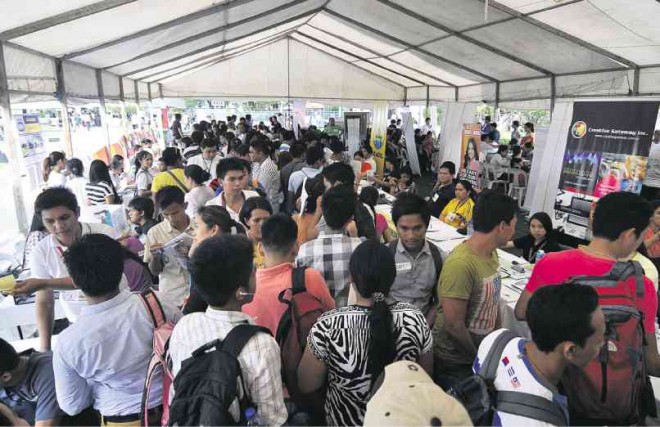The rate of joblessness slid to a new low in October although underemployment—or the lack of better jobs among those already employed—inched up, the government reported Tuesday.
The results of the Philippine Statistics Authority’s (PSA) October 2016 Labor Force Survey (LFS) showed that the unemployment rate declined to 4.7 percent—the lowest during the past decade—from 5.6 percent in the same month last year.
“With the decrease of unemployment in October, our implied full-year unemployment rate will be 5.5 percent, exceeding the government target for 2016 of 6.5-6.7 percent,” Socioeconomic Planning Secretary Ernesto M. Pernia said in a statement.
According to state planning agency National Economic and Development Authority, the employment rate of 95.3 percent last October translated to 41.7 million Filipinos with jobs.
Neda said the latest employment rate figure was the highest among the October rounds of the quarterly LFS since 2006.
“This means that the growth of our economy is becoming more inclusive as it engages more and more Filipinos to participate in the labor market,” said Pernia, who is also the Neda chief.
Amid the growing business process outsourcing (BPO) and tourism industries, the services sector accounted for the biggest share or 54.9 percent of total employment, equivalent to 22.9 million Filipinos.
The construction boom as well as manufacturing resurgence, meanwhile, helped the industry sector corner 17.2 percent or 7.2 million of the total employed.
“This continuing drop in joblessness is consistent with the rapid 7.1-percent expansion of the economy in the third quarter. The surprise expansion in agriculture and the sustained post-elections uptick in the construction sector may have also underpinned this improvement,” Bank of the Philippine Islands lead economist Emilio S. Neri said in an e-mail to reporters.
“The P3-trillion budget approved by the previous administration gave the new administration enough space to follow through with big-ticket projects already in the pipeline. The private construction sector benefitted most from this,” Neri added.
Neri said the Duterte administration’s plan to ramp up infrastructure spending is expected to generate more jobs. “If more big-ticket public infrastructure projects will be approved by the first quarter of 2017, together with those already signed by Neda in the last five months, we can expect more construction projects in the second half of 2017 that can help ramp up our already improving unemployment figures.”
Also, Neda noted that the number of stable wage and salary employment increased to 25.3 million or three-fifths of total employed persons—the highest October figure in a decade, with the private sector providing almost fourth-fifths of these stable jobs.
But Pernia noted that more than a third of those who were employed remained vulnerable. “A large portion of those employed, especially in the agriculture sector, are susceptible to external shocks and economic downturns,” Pernia said.
However, the October 2016 LFS also showed that the underemployment rate slightly rose to 18 percent from 17.6 percent a year ago. As such, the underemployment rate could settle at about 18.4 percent by yearend, Neda said.
The PSA defines the underemployed as “employed persons who express the desire to have additional hours of work in their present job, or to have additional job, or to have a new job with longer working hours.” WITH A REPORT FROM TINA G. SANTOS
